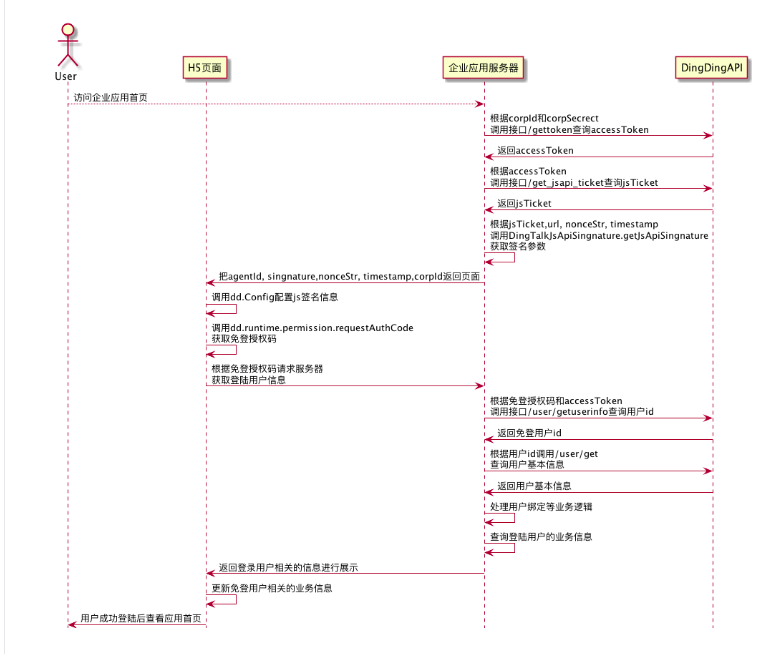在使用钉钉管理企业时,我们可以在钉钉的开放平台注册自建的企业微应用,下面为大家总结下获取用户信息的一些方式.
1.创建企业内应用
创建企业内应用,在此不再多家赘述,请参考官方文档
2.获取用户信息的流程
开发流程详情可在官网查看

- 1.获取accessToken-->jsTicket-->前端配置dd.config-->前端获取authCode-->获取userId-->获取userInfo
- 2.前端获取authCode-->后端获取userId-->获取userInfo
比较两种方式,第一种方式是完全鉴权的方式,适用于对用户信息请求次数较多的场景,如果对用户信息获取次数较少可以使用第二种,免鉴权的方式去请求用户信息
3.具体实现
此处我分享的是第二种场景,对用户信息请求较少的情况,如需实现完全鉴权请参考流程及官网demo进行实现
首先获取accessToken
* get Ding Ding access token
*
* @return
* @throws Exception
*/
public static String getAccessToken(String corpid, String corpsecret) throws Exception {
String url = "https://oapi.dingtalk.com/gettoken?corpid=" + corpid + "&corpsecret=" + corpsecret;
JSONObject response = HttpHelper.httpGet(url);
String accessToken;
if (response.containsKey("access_token")) {
accessToken = response.getString("access_token");
} else {
throw new Exception();
}
return accessToken;
}
前端获取code在此不再赘述,请参考官方文档,通过前端获取的code和accessToken获取userId,官网描述.
* get Ding Ding user id
*
* @return
* @throws Exception
*/
public static String getUserId(String code, String accessToken) throws Exception {
String url = "https://oapi.dingtalk.com/user/getuserinfo?access_token=" + accessToken + "&code=" + code;
JSONObject response = HttpHelper.httpGet(url);
String userId;
if (response.containsKey("userid")) {
userId = response.getString("userid");
} else {
throw new Exception();
}
return userId;
}
通过userId获取用户信息,官网描述
/**
* get Ding Ding user info
*
* @return
* @throws Exception
*/
public static JSONObject getUserInfo(String userId, String accessToken) throws Exception {
String url = "https://oapi.dingtalk.com/user/get?userid=" + userId + "&access_token=" + accessToken;
JSONObject response = HttpHelper.httpGet(url);
JSONObject myObject;
if (response.containsKey("name")) {
myObject = new JSONObject(response);
} else {
throw new Exception();
}
return myObject;
}
HttpHelper我使用的是官网demo中的get请求
public class HttpHelper {
public static JSONObject httpGet(String url) throws DingDingApiException {
HttpGet httpGet = new HttpGet(url);
CloseableHttpResponse response = null;
CloseableHttpClient httpClient = HttpClients.createDefault();
RequestConfig requestConfig = RequestConfig.custom().
setSocketTimeout(2000).setConnectTimeout(2000).build();
httpGet.setConfig(requestConfig);
try {
response = httpClient.execute(httpGet, new BasicHttpContext());
if (response.getStatusLine().getStatusCode() != 200) {
System.out.println("request url failed, http code=" + response.getStatusLine().getStatusCode()
+ ", url=" + url);
return null;
}
HttpEntity entity = response.getEntity();
if (entity != null) {
String resultStr = EntityUtils.toString(entity, "utf-8");
JSONObject result = JSON.parseObject(resultStr);
if (result.getInteger("errcode") == 0) {
return result;
} else {
System.out.println("request url=" + url + ",return value=");
System.out.println(resultStr);
int errCode = result.getInteger("errcode");
String errMsg = result.getString("errmsg");
throw new DingDingApiException(errCode, errMsg);
}
}
} catch (IOException e) {
System.out.println("request url=" + url + ", exception, msg=" + e.getMessage());
e.printStackTrace();
} finally {
if (response != null) try {
response.close();
} catch (IOException e) {
e.printStackTrace();
}
}
return null;
}
}
至此我们就可以将获取的用户信息返回给前端使用,对于用户信息时效性要求较低的场景,我们可以将其保存到cookies中,下次直接使用。